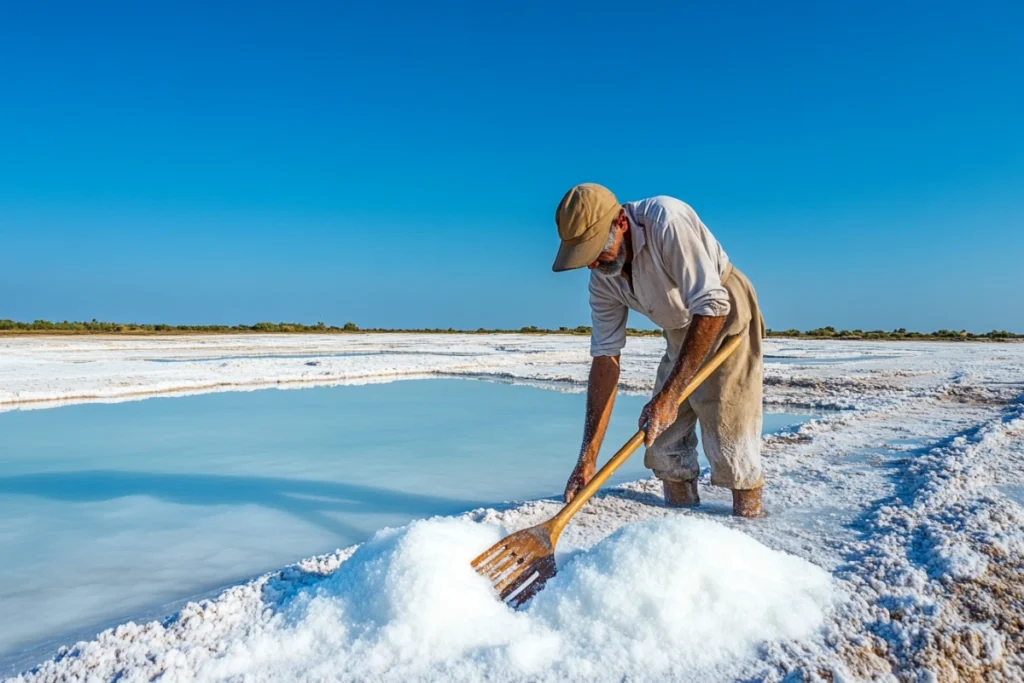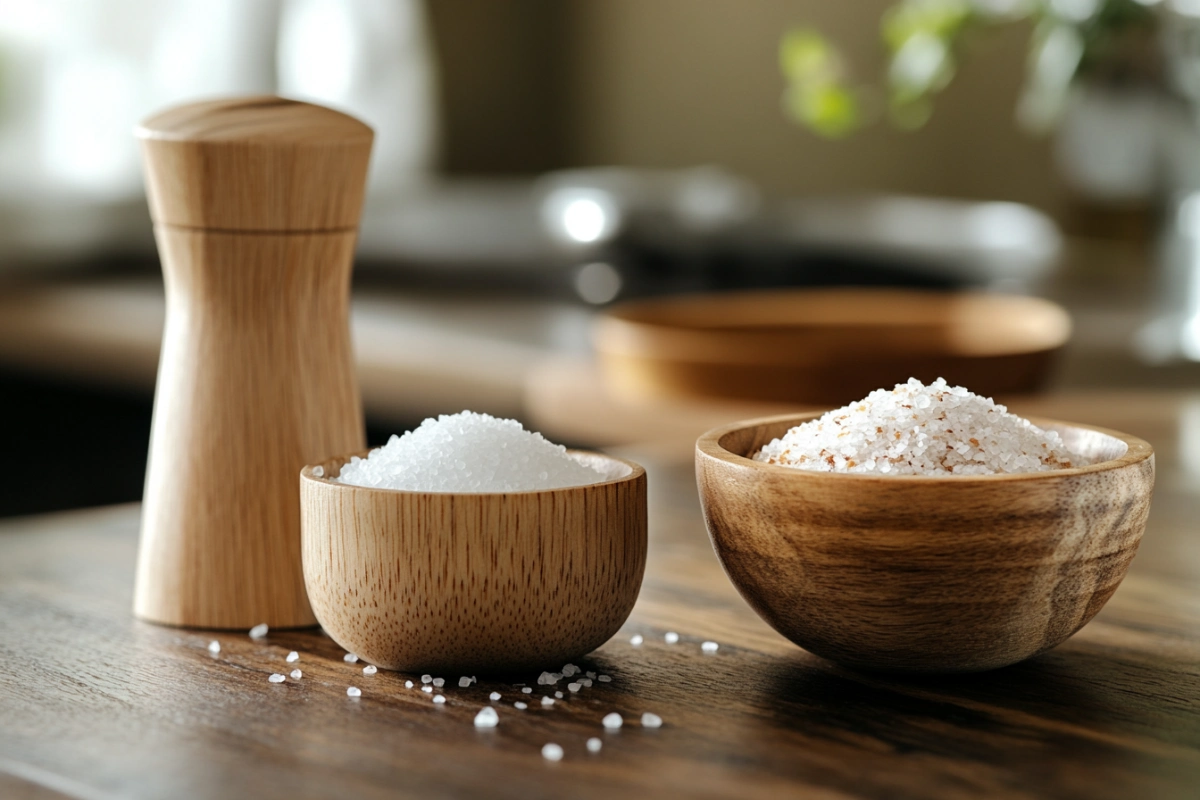Salt is one of the most fundamental ingredients in every kitchen. From enhancing flavors to preserving food, it’s indispensable. But not all salts are created equal. While table salt is a household staple, fleur de sel is a prized culinary gem cherished by gourmets worldwide. This article explores the key differences between these two salts, from their origins and texture to their culinary uses and nutritional profiles. Let’s dive in to discover what makes each unique and how they impact your cooking experience.
Introduction to Table Salt and Fleur de Sel
Salt may seem simple, but it comes in various forms with distinct characteristics. Two popular types, table salt and fleur de sel, differ greatly in terms of production, composition, and culinary applications.
What is Table Salt?
Table salt, also known as common salt, is the refined, everyday seasoning found in salt shakers across the globe. It’s extracted from underground salt deposits or seawater through evaporation. During processing, impurities and minerals are removed, leaving behind nearly pure sodium chloride.
To ensure health benefits, table salt is often fortified with iodine, a mineral that helps prevent iodine deficiency. Anti-caking agents are also added to keep it from clumping. Its fine, uniform grains make it perfect for cooking and baking, but its lack of natural minerals means it offers little beyond its salty taste.
What is Fleur de Sel?
Derived from the French term for “flower of salt,” fleur de sel is an artisanal sea salt traditionally harvested by hand. It forms naturally on the surface of saltwater ponds during warm, windy days. This delicate process is practiced in regions like Brittany, France, especially in Guérande.
Unlike table salt, fleur de sel retains a higher concentration of trace minerals such as magnesium, calcium, and potassium, giving it a nuanced, briny flavor. Its irregular crystals have a slight crunch and dissolve slowly, making it a sought-after finishing salt for gourmet dishes. Its rarity and labor-intensive harvesting contribute to its premium price.
Key Differences Between Table Salt and Fleur de Sel
Salt may seem uniform at first glance, but table salt and fleur de sel are worlds apart in texture, production, and composition. These distinctions explain their varying culinary and nutritional applications.
Texture and Composition
The texture of salt can dramatically influence how it interacts with food. Table salt is composed of uniform, fine granules designed for even distribution and quick dissolution. This makes it ideal for baking and cooking, where consistency is key. However, its highly refined nature often strips away beneficial trace minerals.
In contrast, fleur de sel has a moist, flaky texture with irregular crystals. This structure gives it a delightful crunch when sprinkled over food. Moreover, fleur de sel is naturally rich in magnesium, potassium, and calcium, lending it a more complex flavor profile and slight brininess. These properties make it stand out as a finishing salt in gourmet dishes.
Production Process
The methods used to produce these salts are starkly different. Table salt is industrially manufactured by mining salt deposits or evaporating seawater. It undergoes rigorous processing, including bleaching and the addition of anti-caking agents and iodine to ensure uniformity and shelf stability.
On the other hand, fleur de sel is hand-harvested in specific coastal regions, such as Guérande in France. It forms a delicate crust on salt ponds under precise weather conditions. This artisanal process requires care and expertise, making fleur de sel rare and more expensive.

Culinary Uses of Table Salt and Fleur de Sel
The culinary applications of table salt and fleur de sel are as varied as their characteristics. Each serves its unique purpose in the kitchen.
Everyday Applications of Table Salt
Table salt is a versatile kitchen staple. Thanks to its fine grain, it dissolves quickly and blends seamlessly into recipes. It’s perfect for seasoning soups, stews, and sauces or incorporating into baked goods. Its affordability and availability make it a go-to for everyday cooking needs.
Gourmet Applications of Fleur de Sel
Unlike table salt, fleur de sel is celebrated for its finishing touch. Its nuanced flavor and crunchy texture elevate dishes when sprinkled just before serving. It’s often used on grilled meats, fresh salads, and even desserts like salted caramel and dark chocolate.
For more on using salts creatively in recipes, consider exploring this guide to gourmet salt and its uses.

Health and Nutritional Comparison
Understanding the health impacts of table salt and fleur de sel requires examining their nutritional profiles and processing methods. While both contribute sodium to the diet, their differences in mineral content and additives are noteworthy.
Mineral Content and Additives
Table salt is often fortified with iodine, an essential nutrient that helps prevent iodine deficiency. However, it undergoes heavy processing, removing natural trace minerals like magnesium or potassium. Anti-caking agents are also added to keep it dry and free-flowing.
On the other hand, fleur de sel retains its natural composition due to minimal processing. This allows it to provide beneficial trace minerals like calcium, magnesium, and potassium, making it a healthier option for those seeking more natural seasoning. However, it lacks added iodine, which may be a consideration for people with iodine-deficient diets.
Nutritional Content (Per 100g)
The nutritional composition of table salt and fleur de sel can differ due to processing and mineral retention. Below is a comparison of their nutritional content:
| Nutrient | Table Salt | Fleur de Sel |
|---|---|---|
| Sodium | 38,000 mg | 35,000 mg |
| Potassium | 2 mg | 150 mg |
| Magnesium | 1 mg | 100 mg |
| Calcium | 0 mg | 80 mg |
| Iodine (if fortified) | Up to 70 µg | 0 µg |
Dietary Impact and Recommendations
Excess sodium consumption is a concern, regardless of the type of salt. Table salt is highly concentrated and dissolves easily, often leading to overuse in recipes. Fleur de sel, with its distinct flavor and texture, provides a punch of saltiness, meaning smaller amounts can be used for the same effect.
For a balanced approach, many chefs and nutritionists recommend using fleur de sel as a finishing salt while relying on iodized table salt for cooking. This method ensures both flavor and essential nutrients in the diet.
Price and Accessibility
The cost and availability of table salt and fleur de sel reflect their production methods and intended use.
Affordability of Table Salt
Table salt is inexpensive and widely available, making it a pantry staple in homes around the globe. Its industrial production ensures a consistent supply, making it accessible even in remote areas. Whether used for seasoning, baking, or preserving, its affordability makes it a practical choice for everyday use.
Premium Nature of Fleur de Sel
In contrast, fleur de sel is a luxury item. Hand-harvested in small quantities under specific conditions, its production is labor-intensive and weather-dependent. This rarity contributes to its higher price. However, its bold flavor and texture mean a small pinch goes a long way, justifying the cost for gourmet applications.
If you’re curious about other premium ingredients that elevate dishes, check out this guide to gourmet recipes.
FAQs About Table Salt and Fleur de Sel
Many people wonder, What is the difference between table salt and fleur de sel? To clear up common questions, we’ve addressed some frequently asked topics below.
Why is Fleur de Sel More Expensive Than Table Salt?
Fleur de sel’s premium price stems from its labor-intensive harvesting process. Skilled workers collect it by hand under specific weather conditions, often in small batches. This meticulous method, combined with its rarity and unique characteristics, makes it significantly pricier than mass-produced table salt.
Can Fleur de Sel Be Used as a Substitute for Table Salt?
While fleur de sel can substitute for table salt, it’s best used sparingly as a finishing salt. Its bold flavor and coarse texture shine when sprinkled over dishes just before serving, enhancing flavor and presentation. For cooking and baking, however, table salt’s fine grains are more practical.
What Dishes Benefit Most From Fleur de Sel?
Fleur de sel is perfect for dishes where texture and subtle brininess make a difference. Sprinkle it on grilled meats, roasted vegetables, or even desserts like chocolate truffles or salted caramel. Its crunch and nuanced taste elevate ordinary meals into gourmet experiences.
Does Fleur de Sel Have Health Benefits Over Table Salt?
Fleur de sel contains natural trace minerals like magnesium and potassium, which are often stripped from table salt. While these minerals provide some nutritional benefits, it’s essential to remember that both salts should be used in moderation to avoid excessive sodium intake.
Conclusion
Salt plays a vital role in cooking, but understanding what is the difference between table salt and fleur de sel can transform how you use it in the kitchen. Table salt, with its affordability and versatility, is a practical choice for everyday cooking. Meanwhile, fleur de sel, with its unique texture and gourmet appeal, offers a luxurious finishing touch to elevate your dishes.
Both salts have their strengths and serve different purposes. By knowing when and how to use them, you can balance practicality with indulgence, ensuring your meals are both flavorful and memorable.
Environmental Impact of Table Salt and Fleur de Sel Production
Salt production methods differ significantly, not just in technique but also in their impact on the environment. By understanding these differences, you can make more informed choices.
Environmental Effects of Table Salt Production
Table salt is typically mass-produced through mining or seawater evaporation in industrial facilities. These processes often involve heavy machinery, which contributes to greenhouse gas emissions. Furthermore, mining salt can disrupt ecosystems, harming the environment in the long term.
Additionally, the chemical processing required to refine table salt can generate waste. While necessary for creating a uniform product, this industrialization comes at an ecological cost.
Eco-Friendly Nature of Fleur de Sel Harvesting
In contrast, fleur de sel is harvested by hand in a low-impact, artisanal process. Traditional methods, like using wooden rakes to collect salt crystals from the surface of salt ponds, are environmentally friendly and sustainable. Since no heavy machinery is used, the carbon footprint is minimal.
Moreover, fleur de sel harvesting often supports local communities and preserves age-old traditions. This eco-conscious approach aligns with a growing preference for sustainable food choices.
Choosing and Storing Table Salt and Fleur de Sel
Selecting the right salt can enhance your cooking, but knowing how to store it properly ensures you get the most out of your purchase.
How to Choose the Right Salt for Your Needs
When deciding between these two types of salt, consider how you’ll use them. If you need a reliable, affordable seasoning for everyday cooking, table salt is your best bet. It dissolves quickly and distributes evenly, making it ideal for soups, sauces, and baked goods.
On the other hand, choose fleur de sel for its luxurious finishing touch. Its crunchy texture and briny flavor elevate dishes, whether you’re garnishing steak or sprinkling it over desserts. Keep in mind that a little goes a long way, so a small investment can last for months.
Tips for Proper Salt Storage
To maintain the quality of your salt, store it in a cool, dry place away from moisture and sunlight. Use airtight containers to prevent clumping, especially for table salt, which contains anti-caking agents that can degrade over time.
For fleur de sel, ensure the container seals tightly to preserve its natural moisture. Avoid using metallic containers, as they may alter the flavor. Proper storage guarantees that both types of salt stay fresh and flavorful.

